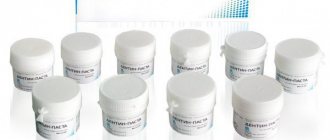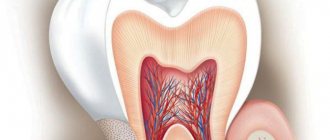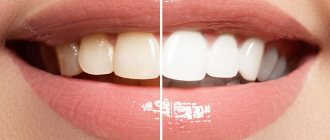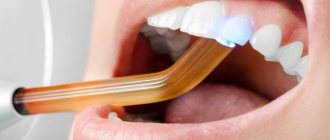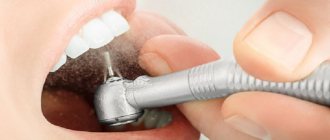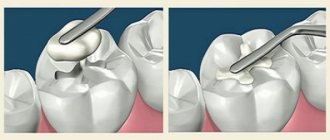Dentin destruction refers to deep carious lesions. In this case, not only the enamel is destroyed, but also the tissues located under it. At this stage, the defect is usually noticeable upon examination and causes discomfort in the patient. Treatment of dentin caries has its own peculiarities and must be carried out immediately, otherwise the patient will lose the tooth. The process can take many years to develop; the disease is typical for people who rarely visit the dentist.
| Prices for treatment of dentin caries | |
| Dentin caries | 4500-5500 R |
Causes
The cause, as with any caries, is bacteria developing in dental plaque. At the initial stage, the enamel is affected. If at this stage the patient does not go to the clinic and receive treatment, the process progresses. It involves deeper tissues. Dentin is less durable than enamel, so destruction occurs more rapidly. In just a few months, the disease can lead the patient to a prosthetist.
If the destructive process has reached the pulp, acute pain occurs. Such patients require emergency dental care. Through the canal, infection can penetrate into the root area, causing serious complications requiring surgical intervention.
Material properties
The main feature of Dentin paste is that under the influence of oral moisture it becomes hard within two hours.
During curing, the material gradually swells, as a result of which the substance adheres to the carious cavity as tightly as possible.
During hardening, the paste becomes durable and strong, has excellent adhesion to hard dental tissue, has an antiseptic effect, and is resistant to almost any load.
This product has no contraindications, it does not provoke allergic reactions or irritation of the oral mucosa, and is well tolerated by patients.
The material is very technologically advanced and easy to use. It provides an airtight seal around the carious hole and does not dissolve in saliva. When filling with amalgam, the oily dentin will prevent the tooth from changing its color.
Symptoms of dentin caries
Many patients do not complain and the affected tooth does not bother them. But some people note short-term pain when eating hot, cold, sour, or sweet foods. These sensations are transient in nature and occur periodically. In the absence of therapy, pain occurs more often, and if the canal wall is damaged, it becomes acute.
If the teeth in the smile area are affected, the patient can independently see a change in the color of the enamel or a carious cavity. After eating, food debris often accumulates at the site of injury, which is difficult to remove. The use of floss is difficult; it clings to the uneven edges of the carious cavity.
When examined using a dental mirror, a violation of the integrity and a change in the color of the tooth tissue are revealed. With a long-term process, the enamel and dentin are dark, and with rapidly developing caries, they are lighter. If the damage is deep, pain is noted when the probe is pressed on the wall of the cavity. The same reaction occurs when blowing with cold air.
To accurately determine the size of the lesion and its proximity to the pulp, radiography is performed. The image clearly visualizes the shape and size of the carious cavity. To determine the viability of the pulp, EDI is performed. This diagnostic method is necessary to decide whether endodontic treatment is necessary. An EDI of more than 50 μA indicates chronic pulpitis and serves as an indication for pulp removal and canal filling. If this indicator is more than 100 μA, there is a high probability of damage to periodontal tissue.
Classification
There are acute and chronic forms of the disease. The form determines how quickly the process will develop and what the consequences will be.
Signs of an acute process:
- Rapid development. In a short period, pulpitis may develop, and the tooth will be completely destroyed.
- Dentin is soft and easily removed with dental instruments.
- The color of damaged tissue is light.
- The edges of the cavity are sharp, the walls are steep.
In a chronic process:
- Caries can take years to develop.
- The walls of the cavity are dark, almost black.
- Dentin is hard and cannot be removed with dental instruments.
- The edges of the cavity are smooth, the walls are flat.
Acute caries often develops on a child’s baby teeth and must be treated immediately. This development of the process is possible in adults.
Treatment
Dentin caries is treated using a drill. Minimally invasive methods for deep lesions are ineffective. For restoration, composite filling materials are usually used, and in children - cement fillings. If the degree of destruction of the visible part of the tooth does not allow the installation of a filling, prosthetics using crowns is used. If a large cavity is formed after preparation, a good effect can be achieved using ceramic inlays.
Due to the proximity of the canal, dentin caries must be treated under local anesthesia. Modern drugs are effective and do not cause allergic reactions or side effects. They can even be used in children and pregnant women. There is no pain during the procedure.
Using a bur, the dentist gradually removes damaged enamel and dentin. It is important not to leave areas of destruction, as this will lead to relapse of the disease. After removing non-viable tissue, a cavity is formed, optimal in shape for filling, and treated with antiseptic solutions. This allows you to remove bacteria that cause the destructive process.
Before installing the filling, the surface is etched using a special composition. This improves the adhesion of the material and ensures long service life of the filling.
If the integrity of the canal is compromised or the pulp is not viable, endodontic treatment is necessary. Its price is higher than simple therapy, but sometimes it is impossible to do without the procedure. The doctor opens the canal, removes the nerve and blood vessels. The channel expands and is filled with special material. To determine the quality of endodontic treatment, an x-ray is taken. The material should be evenly distributed from the top to the base of the canal. After depulpation, a regular filling is placed.
Modern clinics use durable and aesthetic photopolymer materials that harden under the influence of a special lamp. Composites are reliably connected to the tooth surface and last for many years. After installing the filling, the doctor begins to adjust its shape and polish it. The material must completely follow the contours of the tooth, not cause discomfort, or disturb the bite. At the final stage, the restored surface is polished to a shine.
In the first few days after treatment, it is not recommended to eat foods containing food dyes. They can give the photopolymer an undesirable tint. Subsequently, the composite will no longer be painted.
What is a temporary filling and when is it needed?
Root canal treatment in adults is a long process that includes several stages. One of them is the installation of a temporary filling. It is carried out after filling. The main indication for installing a temporary filling is to protect the open canal from external flora. Filling is also carried out for therapeutic purposes. In this case, various medications (antiseptic, antibacterial and other pastes) can be used for it.
Installation of a temporary filling is needed for:
- root canal cleansing;
- disinfection (statistically, temporary filling destroys up to 97% of pathogenic microorganisms);
- prevention of inflammation;
- activation of recovery processes.
In general, the main task of temporary filling is to prevent complications and provide protection to open canals during the treatment process.
In this case, temporary filling is not always done, but only if indicated. In this case they are as follows:
- pulpitis of various types;
- periodontitis (acute or chronic);
- pulp necrosis;
- abscess;
- tooth root fracture, wall perforation, and resorption.
Indications also include pain, swelling and redness of the gums. The need for installation is determined by a specialist during the diagnostic process. In some cases, a temporary filling is placed after the nerves are removed. After this, a permanent filling can be installed, which is installed for a long period of time and serves for many years.
A temporary filling can be installed for several weeks. But more often it is replaced with a permanent one at the next visit to the doctor. With the help of temporary filling, it is possible to disinfect the canals and prevent inflammatory processes.
Complications
Dentin caries is often complicated by pulpitis - inflammation of the pulp. This occurs when the integrity of the canal is violated and infection penetrates into it. In this case, severe toothache occurs, which does not go away on its own.
In the absence of dental care, bacteria penetrate into the tooth root area, causing inflammation of periodontal tissue and osteomyelitis - inflammation of the jaw bone tissue. In such cases, surgical treatment is necessary.
Advanced dentin caries often leads to tooth loss, so do not postpone a visit to the dentist if symptoms of the disease appear. In leading clinics in Moscow, doctors diagnose caries even at the spot stage and carry out minimally invasive, effective treatment.
Release form
- Paste (jar) -50 g
- Instructions for use - 1 pc.
- Cardboard packaging - 1 pc.
Storage conditions Store in a dry place (relative humidity < 50%) in tightly closed containers at temperatures from +5°C to +25°C. Avoid exposure to moisture, direct sunlight and the presence of heating devices in the immediate vicinity!
Shelf life: 2 years.
Disposal Remains of Dentin Paste material and packaging are safe for the environment and can be classified as household waste and disposed of according to the rules established in a medical institution on the basis of current legislation.
Failure to comply with storage conditions leads to changes in the performance characteristics of the material and a reduction in its shelf life.
Prevention of dentin caries
Visit your dentist at least twice a year. The initial stages of caries cannot be detected independently, but the pathology is visible to the doctor during examination. Superficial lesions are treated without a drill, which allows maximum preservation of healthy tissue and restoration of enamel that has undergone demineralization. If the tooth begins to periodically ache, changes color, or light or dark spots appear on its surface, make an appointment with the clinic as soon as possible.
Oral hygiene is the key to healthy teeth. Brush your teeth twice a day with a high-quality toothpaste, and after eating, rinse your mouth and floss. This will help remove food debris from hard-to-reach places and reduce the risk of plaque formation. Even with careful oral care, you still need to have your teeth professionally cleaned by your dentist periodically. This allows you to remove deposits from places inaccessible to a brush and floss, and deal with hard deposits.
Take care of the enamel, do not chew hard objects. Invisible microcracks serve as entry gates for infection and contribute to the development of the carious process. Do not use hard brushes or apply strong pressure when brushing your teeth.
Eat well. Vitamins, minerals and vegetables in sufficient quantities make teeth strong and gums healthy.
Dentin caries is the result of poor oral care and inattention to one’s own health. You can prevent this disease by visiting your dentist promptly and taking proper care of your mouth.
Artificial dentin filling: composition and features
Most often, temporary fillings are made from artificial dentin or dentin paste. The composition of the materials is the same. In the first case, a powder is used, which does not contain oils. It includes zinc oxide, zinc sulfate, as well as white clay. Water is used to give the desired consistency. The composition hardens literally instantly - within 1-3 minutes, so it is easy to glue it.
The hardening of the paste is affected by body temperature and fluid in the oral cavity. This usually takes about 2 hours.
The cements that are included in the composition have high strength. They are used to treat chewing teeth, which bear a lot of stress.
Pastes that polymerize under the influence of light (light-curing) are convenient and quickly harden. This allows you to combine them with various medications. At the same time, the correct installation technology is important so that the seal does not fall off. It is also necessary to carefully brush the tooth on which the temporary filling is located.
Regardless of the composition of temporary fillings, they meet the following criteria:
- Ease of use and high ductility.
- Safety for patients.
- Ensuring good adhesion, high-quality sealing.
- Ability to withstand stress when eating food.
Do you need a temporary filling installed? Contact your medical office. We operate under a license and provide various dental services. Dentistry employs experienced doctors who successfully solve even the most complex problems. We offer a variety of dental services for children and adults: whitening, prosthetics (installation of dentures, crowns), caries treatment, implantation, installation of ceramic veneers and much more. And
Make an appointment with a dentist at a convenient time by calling us by phone or using the feedback form. On the site you can read useful articles and get acquainted with prices for services.
